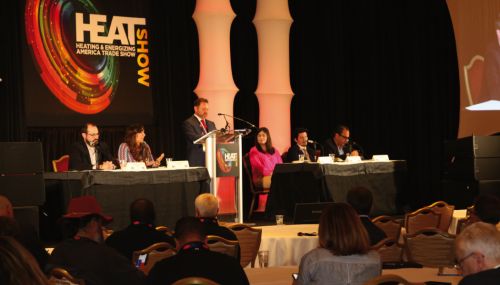All
CEMA Answers the Call

The organization’s president, Chris Herb speaks with Oil & Energy
Chris Herb didn’t exactly take a conventional path to his industry leadership role, but you would be hard-pressed to find someone in the state of Connecticut who has worked as effectively for fuel dealers and consumers in this century.
Formerly an elected Burgess of Naugatuck, a legislative aide for the Connecticut General Assembly and the Director of Public Support for American Red Cross, Herb joined the Connecticut Energy Marketers Association (CEMA) 17 years ago. He was named acting president in March 2013, just a few months after the organization had changed its name from the Independent Connecticut Petroleum Association and only one week after he’d helped strike down a proposed statewide heating oil tax.
Four and a half years later, Herb remains president of CEMA, and with the state’s fuel dealers once again facing the prospect of a heating oil tax, he remains on the frontline, fighting on their behalf.
Oil & Energy Editor Samuel Diamond reached out to Chris Herb for an extensive interview covering CEMA’s latest legislative efforts and a host of other topics.
SD: Let’s tackle the most pressing issue first: what’s the latest on the Department of Energy and Environmental Protection (DEEP) situation?
CH: DEEP released their updated energy plan 10 months after it was statutorily due. They are currently conducting six regional public hearings so that the industry and the public can make recommendations. The new plan is essentially an “electrification plan” that stays the course on natural gas expansion and conversion.
DEEP’s failure to attract interstate natural gas supplies has jeopardized electricity generation and the ability to literally keep the lights on, and now they have an energy plan that moves millions of people to electric vehicles, converts hundreds of thousands of homes and businesses to natural gas, and is looking to utilize electric heat pumps for heating, which seems to make a bad situation much worse.
Both our heating and motor fuels members are motivated to take on DEEP and their irresponsible energy plan. The 2013 plan failed to produce lower electric rates and heating costs as promised, and I believe that the department has lost all credibility with the legislature and the public. We will leverage that to help us defeat this new plan.
SD: When DEEP’s new plan was released, CEMA’s response was immediate. What was done in advance of the release and afterward to ensure that word got out?
CH: Over the past year and a half, we have participated in scoping and technical meetings sponsored by DEEP where we were able to draw some conclusions about what was likely to be included in the plan. That allowed us to work with our Legislative Committee and Board of Directors on how the association would respond once it came out. Once it was finally released, we sent a simple email to key members of the media, and next thing you know, we were on the noon news articulating our opposition.
SD: On the issue of state budgeting, CEMA has proposed a number of revenue-raising solutions. How have those been received?
CH: We proposed three non-tax revenue-generating ideas to legislators to help them with the state’s $5.1 billion deficit. They include changing petroleum gross receipts to a cents-per-gallon tax from a percentage tax (currently at 8.81%), allowing for the sale of beer in c-stores, and increasing the minimum markup on cigarettes. Our proposals are relatively small compared to the deficit and face strong opposition from package store owners and the cigarette lobby. The longer it takes to get a budget passed, the more support we generate, but it has been a struggle to get these concepts incorporated into the budget, because of the opposition.
SD: In 2011 and 2017, Connecticut took up Bioheat® fuel legislation. Both times, it wasn’t enacted. However, next year, your state, along with the rest of New England, will move to the 15ppm ULSHO standard. What positives can you take from the ULSHO switch and apply to biofuel advocacy?
CH: Consumers demand clean affordable fuel and that is what CEMA members are delivering. The move to 15ppm fuel represents a 95 percent reduction in sulfur content, which, coupled with a 7% biodiesel blend (according to our NORA-funded 2016 University of Connecticut heating oil study), makes us the cleanest commercially available heating fuel in America! Since we can continue to deliver a cleaner fuel as biodiesel concentrations increase, I believe that our members will lead the energy revolution by selling higher blends in the future. With NORA’s help, consumers are catching on to the Bioheat® story and excited to use the renewable fuel.
SD: The BioheatNow website and TV campaign seem to specifically target millennial consumers. Was that the goal?
CH: All of our customers are important, but at the same time we recognize that a generational switch is occurring and the largest generation of Americans with increased earnings and buying power are the Millennials. While the “I Did Not Know That” campaign is not solely focused on them, it does use research from a Connecticut consumer attitude study that gave us clear and unbiased data on what our fuel’s strengths and weaknesses are. The study allowed us to leverage the messages that we now know resonate most with our customers (especially Millennials). Our study empirically demonstrated that Bioheat® is the most compelling reason consumers stay with Oilheat. The problem is eight out of 10 consumers “did not know” what Bioheat is. Our campaign leverages those two very important facts to help educate consumers about our fuel and maintain our market share.
SD: What’s the role of CEMA’s Next Generation Leadership Council, and where did the idea for it come from?
CH: For years I was the youngest person in the room, and suddenly I looked around and that was no longer the case. I have been with the association for 17 years, but since I was appointed President, a couple of defining events occurred that led to the creation of this group. The first happened at a regional chapter meeting when the 2013 energy plan was released, and I was briefing our members on the natural gas conversion goals. A young man from Imperial Oil by the name of Mike Sanzo came up to me and said that he was not really aware of what the state was doing and wanted to get involved and get more information directly from CEMA. This was the first time that I recognized that younger people in our industry are not always up-to-date on industry happenings.
The second incident was related to two unexpected deaths of owners who left family businesses to their children who had few of the skills needed to take over. CEMA assisted these individuals in every way we could, but that was the moment I knew that we needed to develop the next generation of company owners and leaders. Peter Aziz of Bantam Home and Energy was the Chair of our Board of Directors, and Craig Snyder of Wesson Energy was the Vice Chair, and when I told them about what was going on and what I wanted to do, they blessed the effort and have worked to make it a success since it was established about two years ago.
SD: I understand that some CEMA members recently ran into trouble collecting payment for their LIHEAP and WAP services and that CEMA has stepped up on behalf of those members. What’s the latest on that front?
CH: A few months ago I learned that the Community Action Agency of New Haven owed nearly 50 of our members approximately $200,000 from LIHEAP fuel deliveries and WAP heating system installations dating back to December 2016. Once we defined how big the problem was and who was owed money, we immediately engaged the Department of Social Services (DSS), which oversees the program, and policymakers to solicit their support. Currently, 15 members are still owed money, and we continue to seek a solution to make sure that they are made whole. At CEMA’s request, the DSS Commissioner met with our members to outline the efforts that the department was making to get them paid.
We are also focused on reforming the program so that this never happens again. Two members affected by the situation, George Perrelli of F. Perrelli and Sons Fuel and Ed Ryan of Ryan Oil, and I met with the president of the State Senate, who committed to working with us on getting everyone the money that they are owed and fixing the program going forward. While the most important thing is getting all of our members paid, we are optimistic that all of the right people are working on our behalf to make that happen.
SD: What’s new at ENTECH [the state-certified technical school affiliated with CEMA]?
CH: Our core offerings continue to be focused on HVACR licensing, CDL licensing, CETP training, and BPI certification (through our partners at the School for Energy Efficiency in Waterbury), but we have expanded our training by entering into contracts with Gateway Community College, New Haven Housing Authority, Tunxis Community College, New Haven Environmental Protectors and others.
We are excited about extending our reach beyond heating and cooling, because it has the potential to attract new talent to our trade. We are working on offering the theory part of our curriculum online so that students can complete our licensing program at their convenience, but we still provide the essential hands-on training that we are known for at our Cromwell location. We are also looking at a mobile classroom concept where we can bring the hands-on part of our program on the road to accommodate students who would otherwise have to travel farther to get to our school.
We have the best instructor in the industry providing the highest level of instruction, and that is because unlike other trade schools, we answer to a higher authority — our members. Our School Advisory Board, chaired by Jim Hickey of Gault Family Companies, keeps ENTECH at the forefront of new technology and in touch with the industry’s training demands.
SD: The school is a vehicle for technical training, but lately I’ve also been seeing CEMA facilitate seminars geared at dealer education. Do you see any crossover between technical training and dealer education?
CH: We have always had a vibrant management education program, but the training provided to owners and technicians is growing closer to each other every year. In addition to the bio-blending seminar that we recently conducted, which attracted both owners/management level staff and people on the technical side of the business, we are working on training that focuses on intergenerational communication, sales skills for everyone in the company, teambuilding, and diversification, among other areas. The energy industry is rapidly changing, and that provides us with ample opportunities to offer useful training that delivers value to managers and technical people.
SD: In July, we talked a bit about the successes of Upgrade & Save CT, but we didn’t really delve into its usage as a tool for customer retention. Do you see members using it as such?
CH: The Upgrade & Save program, which provides rebates to consumers who replace old tanks and/or move to high-efficiency Oilheat equipment, is by far the most popular and well-received program that we offer. The rebate program is a perfect complement to the ultra-low sulfur heating oil/Bioheat® story. Customers are less tempted to convert to natural gas when they have access to these rebates and know that they are heating with a renewable fuel. Our members rave about the response that they get when they are able to offer customers a rebate that helps them stay with oil.
SD: This issue of Oil & Energy will be in readers’ hands at SNEEC. In addition to garnering support for the association and the industry, what are CEMA’s goals for this year’s conference?
CH: David Chu and I are so pleased to be able to work with our sister associations in Massachusetts and Rhode Island to provide high quality, cutting-edge education programs that serve marketers in this region. Our goal is to provide thought-provoking topics that deliver value that our members can bring back to their companies once the conference is over. This year, we are especially excited about NORA joining us to provide a technical conference in conjunction with SNEEC, which will diversify the range of issues that will be presented to attendees. Our goal is to provide everyone with something that helps make them better at their job and more profitable!
SD: Do you have any words of encouragement, reminders, or helpful hints for SNEEC attendees who might be reading this issue at the conference?
CH: CEMA, MEMA and OHIRI are here to serve the needs of our guests. If any of our members have any requests or suggestions, please feel free to let us know. Most of all, enjoy the time you have with each other. CEMA leadership often tells me that the most valuable lessons they learn are from other members — so use SNEEC to network and learn from each other! SNEEC is about our future, growing our industry, expanding knowledge and skills, and having some fun doing it.
SD: Congratulations on the first issue of Agis. What’s it like to have your own magazine out there, and what do you have in store for future issues?
CH: This has been a goal of ours for a few years, which kept getting pushed to the backburner. We were so excited to finally get it off the ground and into our members’ hands. Unlike our newsletter or e-blasts, Agis is designed to be another way for us to speak to our members about issues that are less time sensitive, but relevant to the industry. Future issues will offer diverse content covering HVACR and energy efficiency, state and federal issues, new technology, convenience store issues, politics and human-interest stories. Since we only plan to publish it a couple of times per year, we want to make our articles as meaningful as possible.
Related Posts
 Spotlight Sessions Illuminate Opportunities and Challenges
Spotlight Sessions Illuminate Opportunities and Challenges
Posted on September 19, 2025
 NEFI Testifies on RFS Changes Affecting the Heating Oil Industry
NEFI Testifies on RFS Changes Affecting the Heating Oil Industry
Posted on August 18, 2025
 From Retailer to Representative: Chris Keyser’s Road to the Vermont State House
From Retailer to Representative: Chris Keyser’s Road to the Vermont State House
Posted on June 16, 2025
 Northeast Working Group for Industry Principles Gets to Work
Northeast Working Group for Industry Principles Gets to Work
Posted on May 8, 2025
Enter your email to receive important news and article updates.
